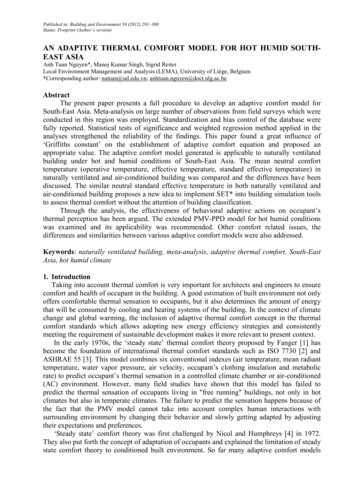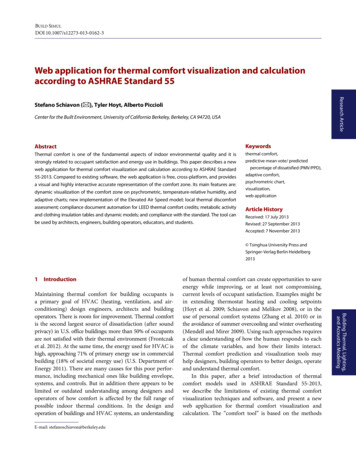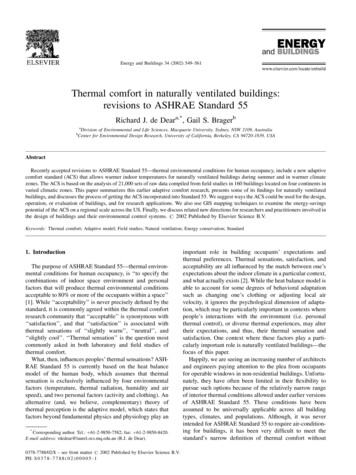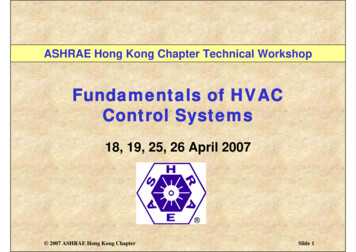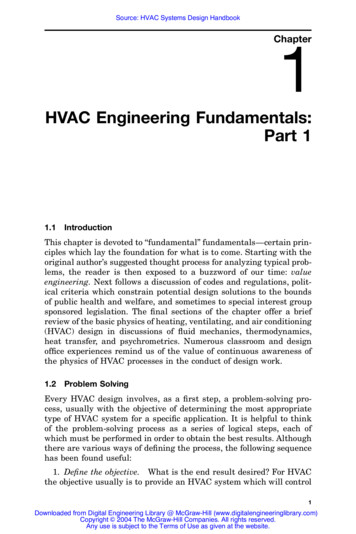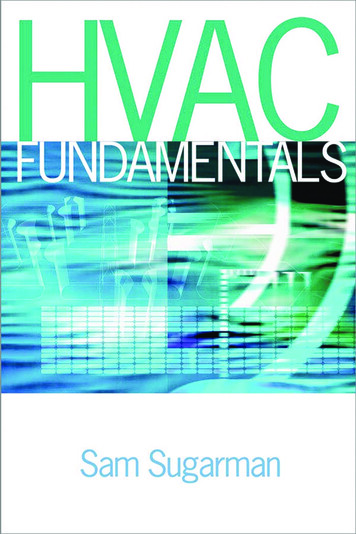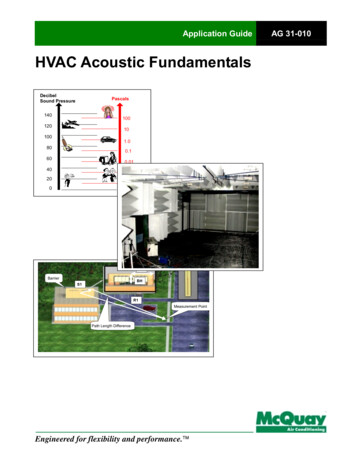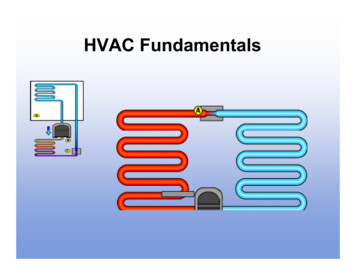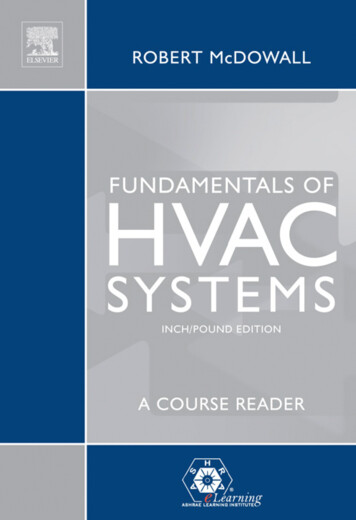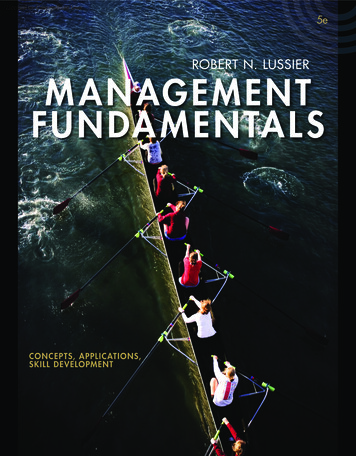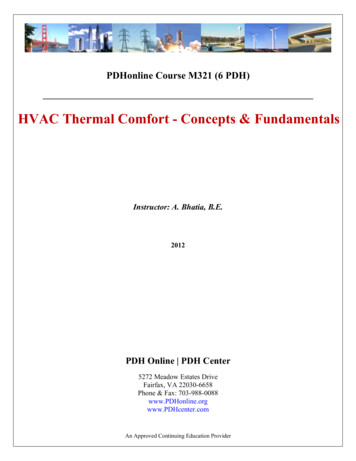
Transcription
PDHonline Course M321 (6 PDH)HVAC Thermal Comfort - Concepts & FundamentalsInstructor: A. Bhatia, B.E.2012PDH Online PDH Center5272 Meadow Estates DriveFairfax, VA 22030-6658Phone & Fax: 703-988-0088www.PDHonline.orgwww.PDHcenter.comAn Approved Continuing Education Provider
www.PDHcenter.comPDH Course M321www.PDHonline.orgHVAC Thermal Comfort – Concepts & FundamentalsA. Bhatia, B.E.HVAC (pronounced either "H-V-A-C" or, occasionally, "H-vak") is an acronym that stands for “heating,ventilation and air conditioning”. HVAC sometimes referred to as climate control is a process of treatingair to control its temperature, humidity, cleanliness, and distribution to meet the requirements of theconditioned space. If the primary function of the system is to satisfy the comfort requirements of theoccupants of the conditioned space, the process is referred to as comfort air conditioning. If the primaryfunction is other than comfort, it is identified as process air conditioning.HVAC systems are also important to occupants' health, because a well regulated and maintainedsystem will keep spaces free from mold and other harmful organisms. The term ventilation is applied toprocesses that supply air to or remove air from a space by natural or mechanical means. Such air mayor may not be conditioned.An air conditioning system has to handle a large variety of energy inputs and outputs in and out of thebuilding where it is used. The efficiency of the system is essential to maintain proper energy balance. Ifthat is not the case, the cost of operating an air conditioning system will escalate. The system willoperate properly if well maintained and operated (assumption was that it was properly designed in thefirst place, however, should sizing be a problem, even a relatively costly redesign might provefinancially beneficial in a long run).The HVAC industry had been historically regulated by the manufacturers of HVAC equipment, butRegulating and Standards organizations such as ASHRAE, SMACNA, ARI, ACCA, Uniform MechanicalCode, International Building Code, and AMCA have been established to support the industry andencourage high standards and achievement.The course comprises 5 sections that describe the fundamental applications of thermodynamics,psychrometrics and heat transfer in HVAC applications.SECTION #1Thermal Comfort – describes the considerations of human comfort, variableaffecting thermal comfort, and related terminology such as mean radianttemperature, wind chill factor, heat index, operative temperature, effectivetemperature and comfort zone. A. BhatiaPage 1 of 61
www.PDHcenter.comSECTION # 2PDH Course M321www.PDHonline.orgPsychrometrics - Describes how to read seven terms dry-bulb temperature, wetbulb temperature, dew-point temperature, relative humidity, humidity ratio,specific enthalpy and specific volume on psychrometric chart. It also describes 4air-conditioning processes viz. mixing; sensible cooling and heating; cooling withdehumidification; and humidificationSECTION # 3Modes of Heat Transfer – Describes heat flow through solids and air. It alsoincludes the terminology and relationships between conductivity, conductance,resistivity, U-factors etc.SECTION # 4Heat Gain and Heat Loss in Building – Includes heat loss/gain calculationprocedure, basic concepts and methods to determine cooling loads, effects ofwindows, walls, roofs and partitions on loads, basic types of internal loads, howto find and use local climate data and effects of air infiltration and ventilation.SECTION # 5HVAC Noise and Vibrations – Describes the concepts of noise emissions andways to reduce noise. A. BhatiaPage 2 of 61
www.PDHcenter.comSECTION -1PDH Course M321www.PDHonline.orgTHERMAL COMFORTThe prime requirement in respect of the indoor climate in a building is that room temperature should beat a comfortable level, regardless of the weather conditions outside. In addition, the indoor air must beacceptably clean, lighting and acoustic conditions must be good etc.Thermal comfort can be defined as a subjective response, or state of mind, when a person expressessatisfaction with the surrounding environment (ASHRAE Standard 55). The environment must providelight, air, and thermal comfort. Proper acoustics and hygiene are also important for physical comfort.While it may be partially influenced by a variety of contextual and cultural factors, a person’s sense ofthermal comfort is primarily a result of the body’s heat exchange with the environment. This isinfluenced by four parameters that constitute the thermal environment (air temperature, radianttemperature, humidity and air speed), and two personal parameters (clothing and activity level, ormetabolic rate).HVAC and Thermal ComfortThe basic purpose of an HVAC system is to provide interior thermal conditions that a majority ofoccupants will find acceptable. Occasionally this may simply require that air be moved at an adequatevelocity to enhance convective cooling and evaporation from the skin. Much more commonly, however,providing for occupant comfort will require that an HVAC system add or remove heat to or from buildingspaces. In addition, it is normally necessary for moisture to be removed from spaces during thesummer; sometimes moisture will need to be added during the winter. The heat and moisture controlfunctions of HVAC systems provide the foundation for key system components. The additionalfunctions of air circulation and air quality control establish further component requirements. In specificbuilding situations, supplemental functions, such as controlling smoke from fires or providingbackground noise for acoustic privacy, may be imposed on an HVAC system -- along with a potentialneed for additional components. In order to explain how thermal interactions affect human comfort, it isfirst necessary to define heat and temperature.Heat and temperatureHeat: Heat may be defined as energy in transit from a high-temperature object to a lower-temperatureobject. This heat transfer may occur by the mechanisms of conduction, convection and radiation. Sensible heat: Kind of heat that increases the temperature of air. It is an expression of themolecular excitation of a given mass of solid, liquid, or gas. A. BhatiaPage 3 of 61
www.PDHcenter.com PDH Course M321www.PDHonline.orgLatent heat: Heat that is present in increased moisture of air. It changes the matter from solid toliquid or from liquid to gas. Heat that is required to change solid to liquid is called latent heat offusion, and that which is required to change liquid to gas is called latent heat of vaporization. Enthalpy: Sum of sensible and latent heat of a substance e.g. the air in our environment isactually a mixture air and water vapor. If the enthalpy of air is known, and the enthalpy ofdesired comfort condition is also known, the difference between them is the enthalpy that mustbe added (by heating or humidification) or removed (by cooling or dehumidification). Units: The common measure of quantity of heat energy is British thermal unit (BTU). It is theheat energy required to raise one pound of water one degree Fahrenheit. The rate of heat flowin this unit is BTUH. The unit is Joule in International System. It is the heat required to raise oneliter of water one degree Celsius. The rate of heat flow in this unit is Joules/sec or Watts (W).One watt per hour is equivalent to 3.412 BTU per hour. (1 Joule 0.0009478 BTU 1 Watt; 1Watt-Hour 0.0009478*60*60 3.412 BTUH.) Temperature: A measure of the degree of heat intensity. The temperature difference betweentwo points indicates a potential for heat to move from the warmer point to the colder point. Unitin English system is Fahrenheit, and in International System is Celsius. Dry-bulb temperature (DB): The dry-bulb temperature is the temperature of air measured by athermometer freely exposed to the air but shielded from radiation and moisture. Morespecifically, it is a measure of the intensity of kinetic energy of the molecules in the air. It is oneof "the most important climate variables for human comfort and building energy efficiency”. Wet-bulb temperature (WB): The temperature registered by thermometer whose bulb iscovered by a wetted wick and exposed to a current of rapidly moving air. It is the temperatureair would have if part of its energy were used to evaporate the amount of water it would absorbto become fully saturated. Dew point temperature: The temperature at which condensation begins when the air is cooled.Variables affecting physical comfortHuman beings are essentially constant-temperature creatures with a normal internal body temperatureof 98.6 F. Heat is produced in the body as result of metabolic activity. If the internal temperature rises A. BhatiaPage 4 of 61
www.PDHcenter.comPDH Course M321www.PDHonline.orgor falls beyond its normal range, mental and physical operation is jeopardized or affected, and if thetemperature deviation is extreme, then serious physiological disorders or even death can result.The physiological interpretation of comfort is the achievement of thermal equilibrium at our normal bodytemperature with the minimum amount of bodily regulation.The factors that affect physical comfort are the following: Metabolic rate: It is the rate at which food consumed is converted into electromechanicalenergy to maintain physical functions. Heat is produced in the body as a result of metabolicactivity. Its production can be controlled to a certain extent, by controlling metabolism oroxidation. Metabolic rate can also be defined as the rate of body heat production underconditions that minimize extra requirements for energy. Given a set of metabolic rate, however,the body must reject heat at the proper rate in order to maintain normal body temperature.Metabolic rate is proportional to body weight, and is also dependent upon activity level, bodysurface area, health, sex, age, amount of clothing, and surrounding thermal and atmosphericconditions. Metabolic rate is measured in Met units. For an average person, one Met unitcorresponds approximately to 360 BTU per hour. A Met is the average amount of heat producedby a sedentary person, and any metabolic rate can be expressed in multiples of this standardunit (e.g. Office work 1 Met).oThe unit of the electromechanical energy produced due to metabolism is the Calorie. ACalorie is defined as the amount of heat required to raise the temperature of 1 gramwater by 1 degree Celsius at 1 atmosphere pressure. This measure is typically used forfood values. 1 Calorie 4.1868 Joules. Conduction is the spontaneous transfer of thermal energy through matter, from a region ofhigher temperature to a region of lower temperature, and acts to equalize temperaturedifferences. It is also described as heat energy transferred from one material to another bydirect contact. Convection is usually the dominant form of heat transfer in liquids and gases. Convection iscirculation of a fluid or gas/air caused by temperature difference. Commonly an increase intemperature produces a reduction in density. Hence, when water is heated on a stove, hot waterfrom the bottom of the pan rises, displacing the colder more dense liquid which falls. Mixing andconduction result eventually in a nearly homogeneous density and even temperature. In HVAC A. BhatiaPage 5 of 61
www.PDHcenter.comPDH Course M321www.PDHonline.orgapplications, convection becomes increasingly effective at dissipating heat as air temperaturedecreases and air movement increases. This is because, “faster the rate of air movement, thelarger the temperature difference between the body and surrounding air, and the larger the bodysurface area, the greater the rate of transfer”. Evaporation: It is exclusively a cooling mechanism. Evaporative losses become a predominantfactor when ambient temperatures are very high. When surrounding temperature is about 70 F,most people lose sensible heat at a rate that makes them feel comfortable. If the surroundingtemperature rises to skin temperature, the sensible heat loss drops to zero. If the ambienttemperature continues to rise, the body gains heat from the environment, and the only way itcan lose heat is by increasing evaporation. The moisture carrying potential of the air determinesthe rate of evaporation and evaporative heat loss. It is dependent on the relative humidity (RH)of surrounding air and the velocity of air motion. Radiation is the only form of heat transfer that can occur in the absence of any form of medium;thus it is the only means of heat transfer through a vacuum. Thermal radiation is a direct resultof the movements of atoms and molecules in a material. Radiation affects two bodies when theyare in direct line of sight of each other. The rate of radiant transfer depends on temperaturedifferential, the thermal absorption capacity of surfaces, and the distance between the surfaces.The body gains or loses heat by radiation according to the difference between the body surfaceand mean radiant temperature (MRT) of the surrounding surfaces.Predictions of Thermal ComfortTwo conditions must be fulfilled to maintain thermal comfort. One is that the actual combination of skintemperature and the body’s core temperature provide a sensation of thermal neutrality. The second isthe fulfillment of the body’s energy balance: the heat produced by the metabolism should be equal tothe amount of heat lost from the body. Excess body heat requires to be continuously dissipated in orderto maintain physical comfort. Mathematically, the relationship between the body's heat production andall its other heat gains and losses is:S - Q skin – Q respiration – W mech MWhere: S Rate of Energy Storage in Body A. BhatiaPage 6 of 61
www.PDHcenter.comPDH Course M321 Q skin Rate of Energy Loss Thru Skin Q respiration Rate of Energy Loss Through Respiration Wmech Rate of Mechanical Work Performed by Body M Metabolic Rate.www.PDHonline.orgThe body always produces
HVAC Thermal Comfort – Concepts & Fundamentals. A. Bhatia, B.E. HVAC (pronounced either "H-V-A-C" or, occasionally, "H-vak") is an acronym that stands for “heating, ventilation and air conditioning”. HVAC sometimes referred to as climate control is a process of treating air to control its temperature, humidity, cleanliness, and distribution to meet the requirements of the conditioned .
